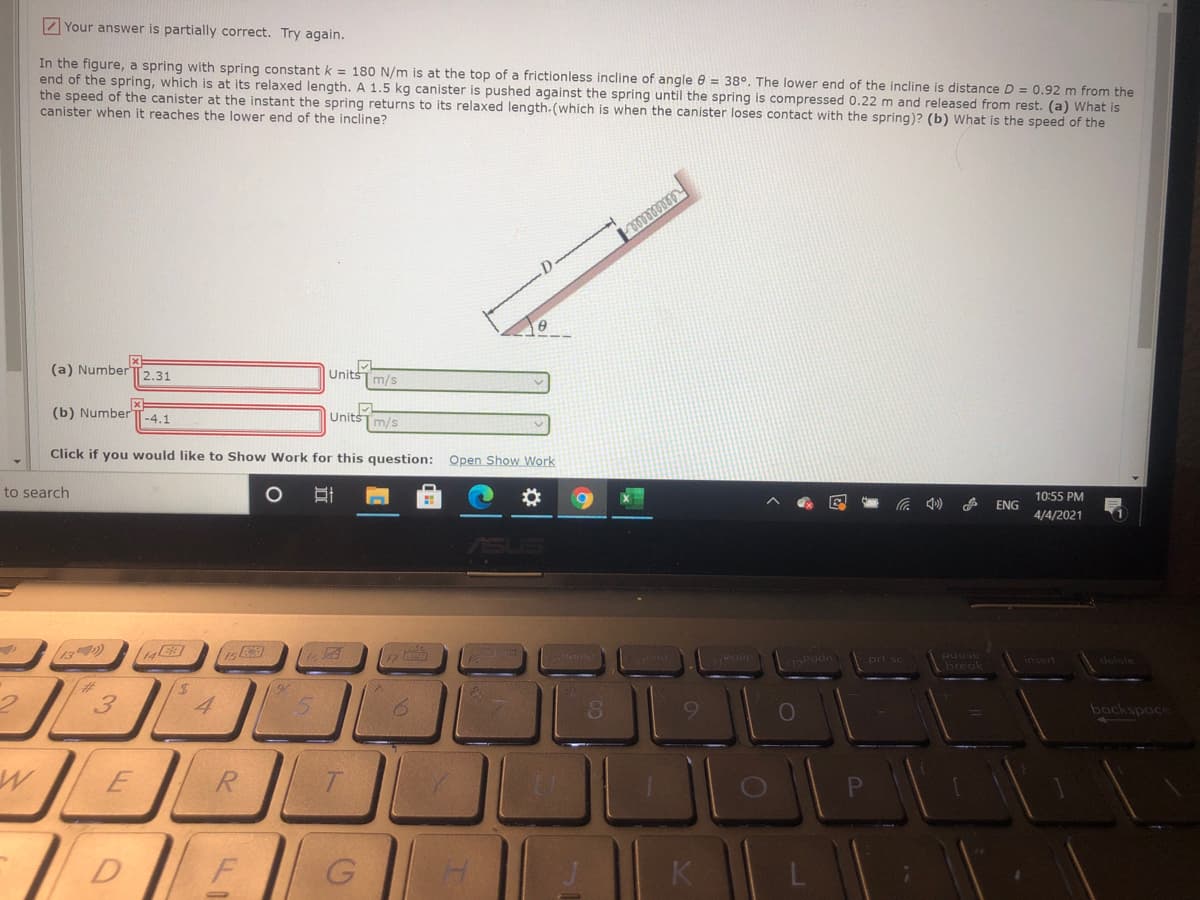In the figure, a spring with spring constant k = 180 N/m is at the top of a frictionless incline of angle e = 38°. The lower end of the incline is distance D = 0.92 m from the end of the spring, which is at its relaxed length. A 1.5 kg canister is pushed against the spring until the spring is compressed 0.22 m and released from rest. (a) What is the speed of the canister at the instant the spring returns to its relaxed length.(which is when the canister loses contact with the spring)? (b) What is the speed of the canister when it reaches the lower end of the incline?
In the figure, a spring with spring constant k = 180 N/m is at the top of a frictionless incline of angle e = 38°. The lower end of the incline is distance D = 0.92 m from the end of the spring, which is at its relaxed length. A 1.5 kg canister is pushed against the spring until the spring is compressed 0.22 m and released from rest. (a) What is the speed of the canister at the instant the spring returns to its relaxed length.(which is when the canister loses contact with the spring)? (b) What is the speed of the canister when it reaches the lower end of the incline?
University Physics Volume 1
18th Edition
ISBN:9781938168277
Author:William Moebs, Samuel J. Ling, Jeff Sanny
Publisher:William Moebs, Samuel J. Ling, Jeff Sanny
Chapter8: Potential Energy And Conservation Of Energy
Section: Chapter Questions
Problem 79AP: Consider a block of mass 0.200 kg attached to a spring of spring constant 100 N/m. The block is...
Related questions
Topic Video
Question

Transcribed Image Text:Your answer is partially correct. Try again.
In the figure, a spring with spring constant k = 180 N/m is at the top of a frictionless incline of angle e = 38°. The lower end of the incline is distance D = 0.92 m from the
end of the spring, which is at its relaxed length. A 1.5 kg canister is pushed against the spring until the spring is compressed 0.22 m and released from rest. (a) What is
the speed of the canister at the instant the spring returns to its relaxed length.(which is when the canister loses contact with the spring)? (b) What is the speed of the
canister when it reaches the lower end of the incline?
(a) NumberT2.31
Units
Im/s
(b) NumberT-4.1
UnitsTm/s
Click if you would like to Show Work for this question: Open Show Work
to search
10:55 PM
ENG
4/4/2021
13)
15
17
padn
pause
insert
delete
%23
9.
backspace
R.
D
F
Expert Solution
This question has been solved!
Explore an expertly crafted, step-by-step solution for a thorough understanding of key concepts.
Step by step
Solved in 2 steps with 2 images

Knowledge Booster
Learn more about
Need a deep-dive on the concept behind this application? Look no further. Learn more about this topic, physics and related others by exploring similar questions and additional content below.Recommended textbooks for you

University Physics Volume 1
Physics
ISBN:
9781938168277
Author:
William Moebs, Samuel J. Ling, Jeff Sanny
Publisher:
OpenStax - Rice University

Principles of Physics: A Calculus-Based Text
Physics
ISBN:
9781133104261
Author:
Raymond A. Serway, John W. Jewett
Publisher:
Cengage Learning

Physics for Scientists and Engineers
Physics
ISBN:
9781337553278
Author:
Raymond A. Serway, John W. Jewett
Publisher:
Cengage Learning

University Physics Volume 1
Physics
ISBN:
9781938168277
Author:
William Moebs, Samuel J. Ling, Jeff Sanny
Publisher:
OpenStax - Rice University

Principles of Physics: A Calculus-Based Text
Physics
ISBN:
9781133104261
Author:
Raymond A. Serway, John W. Jewett
Publisher:
Cengage Learning

Physics for Scientists and Engineers
Physics
ISBN:
9781337553278
Author:
Raymond A. Serway, John W. Jewett
Publisher:
Cengage Learning

Physics for Scientists and Engineers with Modern …
Physics
ISBN:
9781337553292
Author:
Raymond A. Serway, John W. Jewett
Publisher:
Cengage Learning

Physics for Scientists and Engineers: Foundations…
Physics
ISBN:
9781133939146
Author:
Katz, Debora M.
Publisher:
Cengage Learning

College Physics
Physics
ISBN:
9781285737027
Author:
Raymond A. Serway, Chris Vuille
Publisher:
Cengage Learning